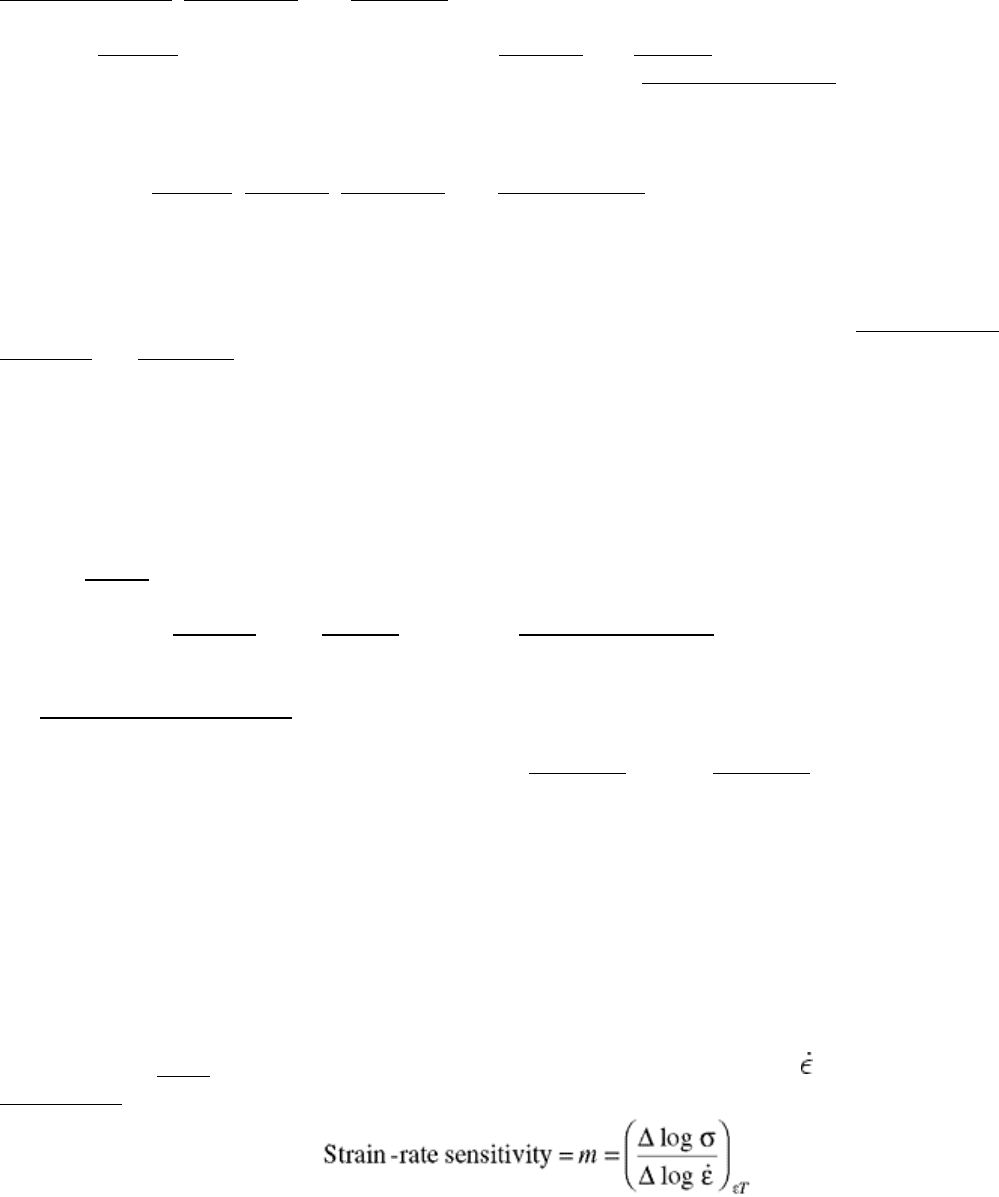ASM Metals HandBook Vol. 8 - Mechanical Testing and Evaluation
Подождите немного. Документ загружается.


The amount of work per unit volume of a material required to carry that material to failure under static
loading. See also toughness.
Mohs hardness test
A scratch hardness test for determining comparative hardness using 10 standard minerals—from talc
(the softest) to diamond (the hardest).
monotron hardness test
An obsolete method of determining indentation hardnessby measuring the load required to force a
spherical penetrator into a metal to a specified depth.
multiaxial stress
See principal stress (normal).
m-value
See strain-rate sensitivity.
N
natural strain
See true strain.
necking
(1) Reducing the cross-sectional area of metal in a localized area by stretching. (2) Reducing the
diameter of a portion of the length of a cylindrical shell or tube.
nominal strain
See strain.
nominal strength
See ultimate strength.
nominal stress
The stress at a point calculated on the net cross section by simple elasticity theory without taking into
account the effect on the stress produced by stress raisers such as holes, grooves, fillets, etc.
normal direction
Direction perpendicular to the plane of working in a worked metal. See also longitudinal direction and
transverse direction.
normal stress
The stress component perpendicular to a plane on which forces act. Normal stress may be either tensile
stress or compressive stress.
notch brittleness
Susceptibility of a material to brittle fractureat points of stress concentration. For example, in a notch
tensile test, the material is said to be notch brittle if the notch strengthis less than the tensile strength of
an unnotched specimen. Otherwise, it is said to be notch ductile.
notch depth
The distance from the surface of a notched test specimen to the bottom of the notch. In a cylindrical test
specimen, the percentage of the original cross-sectional area removed by machining an annular groove.
notch ductility
The percentage reduction in area after complete separation of the metal in a tensile test of a notched
specimen.
notch strength
The maximum load on a notched tensile-test specimen divided by the minimum cross-sectional area (the
area at the root of the notch). Also known as notch tensile strength.
n-value
See strain hardening exponent.
O
observed value
The particular value of a characteristic determined as a result of a test or measurement.
offset

The distance along the strain coordinate between the initial portion of a stress-strain curve and a line
parallel to the initial portion that intersects the stress-strain curve at a value of stress (commonly 0.2%)
that is used as a measure of the yield strength. Used for materials that have no obvious yield point.
offset modulus
The ratio of the offset yield stress to the extension at the offset point (plastics).
offset yield strength
The stress at which the strain exceeds by a specified amount (the offset) an extension of the initial
proportional portion of the stress-strain curve. Expressed in force per unit area.
Olsen cup test
A cupping test in which a piece of sheet metal, restrained except at the center, is deformed by a standard
steel ball until fracture occurs. The height of the cup at time of fracture is a measure of the ductility.
Compare with Erichsen cup test and Swift cup test.
orange peel
A surface roughening in the form of a pebble-grained pattern where a metal of unusually coarse grain is
stressed beyond its elastic limit. Also known as pebbles and alligator skin.
original crack size (a
o
)
The physical crack size at the start of testing
oxidative wear
A type of wear resulting from the sliding action between two metallic components that generates oxide
films on the metal surfaces. These oxide films prevent the formation of a metallic bond between the
sliding surfaces, resulting in fine wear debris and low wear rates. Compare with corrosive wear.
P
parameter
In statistics, a constant (usually unknown) defining some property of the frequency distribution of a
population, such as a population median or a population standard deviation.
pebbles
See preferred term orange peel.
percent error
For testing machines, the ratio, expressed as a percentage, of the error to the correct value of the applied
load.
permanent set
The deformation or strain remaining in a previously stressed body after release of load.
permissible variation
For testing machines, the maximum allowable error in the value of the quantity indicated. It is
convenient to express permissible variation in terms of the percent error.
physical crack size (a
p
)
The distance from a reference plane to the observed crack front. This distance may represent an average
of several measurements along the crack front. The reference plane depends on the specimen form, and
it is normally taken to be either the boundary or a plane containing either the load line or the centerline
of a specimen or plate.
physical properties
Properties of a material the determination of which does not involve the deformation or destruction of
the specimen—for example, density, electrical conductivity, coefficient of thermal expansion, magnetic
permeability, and lattice parameter. Does not include chemical reactivity or the properties more
appropriately regarded as mechanical properties.
physical testing
Methods used to determine the entire range of physical properties of a material. In addition to density
and thermal, electrical, and magnetic properties, physical testing methods can be used to assess simple
fundamental physical properties such as color, crystalline form, and melting point.
pin expansion test

A test for determining the ability of a tube to be expanded or for revealing the presence of cracks or
other longitudinal weaknesses in it, made by forcing a tapered pin into the open end of the tube, similar
to flare test.
pin or mandrel
In bend testing, the plunger or tool used in making semiguided, guided, or wrap-around tests to apply
the bending force to the inside surface of the bend. In free bends or semiguided bends to an angle of
180°, a shim or block of the proper thickness may be placed between the legs of the specimen as
bending is completed. This shim or block is also referred to as a pin or mandrel.
pin shear test
See shear test.
Piobert lines
See Lüders lines.
pitting
In tribology, a type of wear characterized by the presence of small, sharp surface cavities formed by
processes such as fatigue, local adhesion, wear, corrosion, or cavitation.
planar anisotropy
A variation in physical and/or mechanical properties with respect to direction within the plane of
material in sheet form. See also plastic strain ratio.
plane strain
The stress condition in linear-elastic fracture mechanics in which there is zero strain in a direction
normal to both the axis of applied tensile stress and the direction of crack growth (i.e., parallel to the
crack front); most nearly achieved in loading thick plates along a direction parallel to the plate surface.
Under plane-strain conditions, the plane of fracture instability is normal to the axis of the principal
tensile stress.
plane-strain fracture toughness (K
Ic
)
The crack extension resistance under conditions of crack-tip plane strain. See also stress-intensity factor.
plane stress
The stress condition in linear-elastic fracture mechanics in which the stress in the thickness direction is
zero; most nearly achieved in loading very thin sheet along a direction parallel to the surface of the
sheet. Under plane-stress conditions, the plane of fracture instability is inclined 45° to the axis of the
principal tensile stress.
plane-stress fracture toughness (K
c
)
In linear-elastic fracture mechanics, the value of the crack-extension resistance at the instability
condition determined from the tangency between the R-curve and the critical crack-extension force
curve of the specimen. See also stress intensity factor.
plastic deformation
The permanent (inelastic) distortion of a material under applied stress that strains the material beyond its
elastic limit.
plastic flow
See yielding.
plastic instability
The stage of deformation in a tensile test where the plastic flow becomes nonuniform and necking
begins.
plasticity
The property that enables a material to undergo permanent deformation without rupture.
plastic strain
Dimensional change that does not disappear when the initiating stress is removed. Usually accompanied
by some elastic deformation.
plastic strain ratio (r-value)
The ratio of the true width strain to the true thickness strain in a tensile test, r = ε
w
/ε
t
. Because of the
difficulty in making precise measurement of thickness strain in sheet material, it is more convenient to
express rin terms of initial and final length and width dimensions. It can be shown that
r = (ln W
o
W
f
) - (ln L
f
W
f
/L
o
W
o
)

where L
o
and W
o
are initial length and width of gage section, respectively; and L
f
and W
f
are final length
and width, respectively.
plastic-zone adjustment, r
Y
An addition to the physical crack size to account for plastic crack-tip deformation enclosed by a linear-
elastic stress field.
plowing
In tribology, the formation of grooves by plastic deformation of the softer of two surfaces in relative
motion.
point estimate
The estimate of a parameter given by a single statistic.
Poisson's ratio (ν)
The absolute value of the ratio of transverse (lateral) strain to the corresponding axial strain resulting
from uniformly distributed axial stress below the proportional limit of the material.
population
The hypothetical collection of all possible test specimens that could be prepared in the specified way
from the material under consideration. Also known as universe.
precision
The closeness of agreement between the results of individual replicated measurements or tests. The
standard deviation of the error of measurement may be used as a measure of “imprecision.”
principal stress (normal)
The maximum or minimum value of the normal stressat a point in a plane considered with respect to all
possible orientations of the considered plane. On such principal planes the shear stress is zero. There are
three principal stresses on three mutually perpendicular planes. The state of stress at a point may be: (1)
uniaxial, a state of stress in which two of the three principal stresses are zero; (2) biaxial, a state of stress
in which only one of the three principal stresses is zero; or (3) triaxial, a state of stress in which none of
the principal stresses is zero. Multiaxial stress refers to either biaxial or triaxial stress.
proof stress
(1) The stress that will cause a specified small permanent set in a material. (2) A specified stress to be
applied to a member or structure to indicate its ability to withstand service loads.
proportional limit
The greatest stress a material is capable of developing without a deviation from straight-line
proportionality between stress and strain. Compare with elastic limit. See also Hooke's law.
punching shear test
See blanking shear test.
R
radial marks
Lines on a fracture surface that radiate from the fracture origin and are visible to the unaided eye or at
low magnification. Radial lines result from the intersection and connection of brittle fractures
propagating at different levels. Also known as shear ledges. See also chevron pattern.
radius of bend
The radius of the cylindrical surface of the pin or mandrel that comes in contact with the inside surface
of the bend during bending. For free or semiguided bends to 180° in which a shim or block is used, the
radius of bend is one-half the thickness of the shim or block.
range of stress (S
r
)
The algebraic difference between the maximum and minimum stress in one cycle—that is,
S
r
= S
max
- S
min
ratchet marks
Lines on a fatigue fracture surface that result from the intersection and connection of fatigue fractures
propagating from multiple origins. Ratchet marks are parallel to the overall direction of crack
propagation and are visible to the unaided eye or at low magnification.
rate of creep
See creep rate.

R-curve
In linear-elastic fracture mechanics, a plot of crack-extension resistance as a function of stable crack
extension, which is either the difference between the physical crack size,or the effective crack size, and
the original crack size. R-curves normally depend on specimen thickness and, for some materials, on
temperature and strain rate.
reduction in area (RA)
The difference between the original cross-sectional area of a tensile specimen and the smallest area at or
after fracture as specified for the material undergoing testing. Also known as reduction of area.
relaxation curve
A plot of either the remaining, or relaxed, stress as a function of time. See also relaxation rate.
relaxation rate
The absolute value of the slope of a stress-relaxation curve at a given time.
relaxed stress
The initial stress minus the remaining stress at a given time during a stress-relaxation test. See also
stress relaxation.
remaining stress
The stress remaining at a given time during a stress-relaxation test. See also stress relaxation.
repeatability
A term used to refer to the test-result variability associated with a limited set of specifically defined
sources of variability within a single laboratory.
reproducibility
A term used to describe test-result variability associated with specifically defined components of
variance obtained both from within a single laboratory and between laboratories.
residual stress
Stresses that remain within a body as the result of thermal or mechanical treatment or both.
resilience
The ability of a material to absorb energy when deformed elastically and return to its original shape on
release of load. See also modulus of resilience.
response curve for N cycles
In fatigue-data analysis, a curve fitted to observed values of percentage survival at N number of cycles
for several stress levels, where N is a preassigned number such as 10
6
, 10
7
, etc. It is an estimate of the
relationship between applied stress and the percentage of the population that would survive N cycles.
See also S-N curve.
Rockwell hardness number (HR)
A number derived from the net increase in the depth of impression in a Rockwell hardness test as the
load on an indenter is increased from a fixed minor load to a major load and then returned to the minor
load. Rockwell hardness numbers are always quoted with a scale symbol representing the penetrator,
load, and dial used.
Rockwell hardness test
An indentation-hardness test using a calibrated machine that utilizes the depth of indentation, under
constant load, as a measure of hardness. Either a 120° diamond cone with a slightly rounded point, or a
or in. diameter steel ball is used as the indenter.
Rockwell superficial hardness number
See Rockwell hardness number.
Rockwell superficial hardness test
Same as Rockwell hardness test, except that smaller minor and major loads are used.
rosette
Strain gages arranged to indicate, at a single position, strain in three different directions.
rupture stress
The stress at failure. Also known as breaking stress.See also fracture stress.
r-value
See plastic-strain ratio.
S

sample
(1) One or more units of product (or a relatively small quantity of a bulk material) that are withdrawn
from a lot or process stream and that are tested or inspected to provide information about the properties,
dimensions, or other quality characteristics of the lot or process stream. Not be confused with specimen.
(2) A portion of a material intended to be representative of the whole.
sample average
The sum of all the observed values in a sample divided by the sample size. It is a point estimate of the
population mean. Also known as arithmetic mean.
sample median
The middle value when all observed values in a sample are arranged in order of magnitude. If an even
number of samples are tested, the average of the two middlemost values is used. It is a point estimate of
the population median, or 50% point.
sample percentage
The percentage of observed values between two stated values of the variable under consideration. It is a
point estimate of the percentage of the population between the same two stated values. (One stated value
may be -∞ or +∞.)
sample standard deviation (s)
The square root of the sample variance. It is a point estimate of the population standard deviation, a
measure of the “spread”of the frequency distribution of a population. This value of sprovides a statistic
that is used in computing interval estimates and several test statistics. For small sample sizes, s
underestimates the population standard deviation.
sample variance (s
2
)
The sum of the squares of the differences between each observed value and the sample average divided
by the sample size minus one. It is a point estimate of the population variance.
S-basis
Minimum property value specified by the appropriate federal, military, Society of Automotive
Engineers, American Society for Testing and Materials, or other recognized and approved specifications
for the material. See also A-basis, B-basis, and typical basis.
Scleroscope hardness number (HSc or HSd)
A number related to the height of rebound of a diamond-tipped hammer dropped on the material being
tested. It is measured on a scale determined by dividing into 100 units the average rebound of the
hammer from a quenched(to maximum hardness) and untempered AISI W5 tool steel test block.
Scleroscope hardness test
A dynamic indentation-hardness test using a calibrated instrument that drops a diamond-tipped hammer
from a fixed height onto the surface of the material being tested. The height of rebound of the hammer is
a measure of the hardness of the material. Also known as Shore hardness test.
scoring
In tribology, a severe form of wear characterized by the formation of extensive grooves and scratches in
the direction of sliding.
scratch hardness test
A form of hardness test in which a sharp-pointed stylus or corner of a mineral specimen is traversed
along a surface so as to determine the resistance of that surface to cutting or abrasion. See also file
hardness and Mohs hardness test.
scratching
In tribology, the mechanical removal or displacement, or both, of material from a surface by the action
of abrasive particles or protuberances sliding across the surfaces. See also plowing.
scuffing
A form of adhesive wear that produces superficial scratches or a high polish on the rubbing surfaces. It
is observed most often on inadequately lubricated parts.
secant modulus
The slope of the secant drawn from the origin to any specified point on a stress-strain curve. Compare
with chord modulus.See also modulus of elasticity.
semiguided bend

The bend obtained by applying a force directly to the specimen in the portion that is to be bent. The
specimen is either held at one end and forced around a pin or rounded edge, or is supported near the
ends and bent by a force applied on the side of the specimen opposite the supports and midway between
them. In some instances, the bend is started in this manner and finished in the manner of a free bend.
set
See permanent set.
sharp-notch strength
The notch tensile strength measured using specimens with very small notch root radii (approaching the
limit for machining capability); values of sharp-notch strength usually depend on notch root radius.
shear
The type of force that causes or tends to cause two contiguous parts of the same body to slide relative to
each other in a direction parallel to their plane of contact.
shear fracture
A ductile fracture in which a crystal (or a polycrystalline mass)has separated by sliding or tearing under
the action of shear stresses. Contrast with cleavage fracture.
shear lip
A narrow, slanting ridge along the edge of a fracture surface. The term sometimes also denotes a
narrow, often crescent-shaped, fibrous region at the edge of a fracture that is otherwise of the cleavage
type, even though this fibrous region is in the same plane as the rest of the fracture surface.
shear modulus (G)
The ratio of shear stress to the corresponding shear strain for shear stresses below the proportional limit
of the material. Values of shear modulus are usually determined by torsion testing. Also known as
modulus of rigidity.
shear strain
The tangent of the angular change, as a response to force, between two lines originally perpendicular to
each other through a point in a body. Also known as shearing strain.
shear strength
The maximum shear stress that a material is capable of sustaining. Shear strength is calculated from the
maximum load during a shear or torsion test and is based on the original dimensions of the cross section
of the specimen.
shear stress
(1) A stress that exists when parallel planes in metal crystals slide across each other. (2) The stress
component tangential to the plane on which the forces act. Also known as tangential stress.
shear test
Any of several tests to obtain shear strength of a metal. Common tests used on mill products include the
double-shear test, single-shear test, the blanking shear test (also known as the punching shear test) and
the torsion test.
shock load
The sudden application of an external force that results in a very rapid build-up of stress.
Shore hardness test
See Scleroscope hardness test.
short transverse
See transverse direction.
significance level
The stated probability (risk) that a given test of significance will reject the hypothesis that a specified
effect is absent when the hypothesis is true.
significant
Statistically significant. An effect of difference between populations is said to be present if the value of
a test statistic is significant, that is, lies outside predetermined limits. See also population.
silky fracture
A metal fracture in which the broken metal surface has a fine texture, usually dull in appearance.
Characteristic of tough and strong metals. Contrast with crystalline fracture and granular fracture.
single-shear test

(1) A shear test similar to the double-shear test used for round-bar specimens, but that uses only one
stationary shear blade. (2) A shear test that uses a sheet or thin-plate specimen.
size effect
Effect of the dimensions of a piece of metal on its mechanical and other properties and on
manufacturing variables such as forging reduction and heat treatment. In general, the mechanical
properties are lower for a larger size.
slant fracture
A type of fracture appearance, typical of plane-stress fractures, in which the plane of metal separation is
inclined at an angle (usually about 45°) to the axis of the applied stress.
slenderness ratio
The effective unsupported length of a uniform column divided by the least radius of gyration of the
cross-sectional area.
slip
Plastic deformation by the irreversible shear displacement (translation)of one part of a crystal relative to
another in a definite crystallographic direction and usually on a specific crystallographic plane.
Sometimes called glide.
slip band
A group of parallel slip lines so closely spaced as to appear as a single line when observed under an
optical microscope. See also slip line.
slip line
The trace of the slip plane on a viewing surface; the trace is usually observable only if the surface has
been polished before deformation. The usual observation on metal crystals (under the light microscope)
is of a cluster of slip lines known as a slip band.
S-N curve
A plot of stress, S, against the number of cycles to failure, N. The stress can be the maximum stress,
S
max
, or the alternating stress amplitude, S
a
. The stress values are usually nominal stresses; i.e., there is
no adjustment for stress concentration. The curve indicates the S-N relationship for a specified value of
the mean stress, Sm or the stress ratio, A, or Rand a specified probability of survival. For N, a log scale
is almost always used. For S, a linear scale is used most often, but a log scale is sometimes used. Also
known as S-N diagram.
S-N curve for 50% survival
A curve fitted to the median value of fatigue life at each of several stress levels. It is an estimate of the
relation between applied stress and the number of cycles-to-failure that 50% of the population would
survive.
S-N curve for p% survival
A curve fitted to the fatigue life for p% survival values at each of several stress levels. It is an estimate
of the relationship between applied stress and the number of cycles-to-failure that p% of the population
would survive. p may be any number, such as 95, 90, and so forth.
spalling
The separation of macroscopic particles from a surface in the form of flakes or chips.
specimen
A test object, often of standard dimensions or configuration, that is used for destructive or
nondestructive testing. One or more specimens may be cut from each unit of a sample.
springback
The extent to which metal tends to return to its original shape or contour after undergoing a forming
operation.
standard deviation
The most usual measure of the dispersion of observed values or results expressed as the positive square
root of the variance.
static fatigue
A term referring to a time-dependent reduction in strength with a static (noncyclic) load. The term may
refer to hydrogen-induced delayed cracking or the effect of creep on the strength of plastics.
statistic
A summary value calculated from the observed values in a sample.

steady loads
Loads that do not change in intensity or that change so slowly they may be regarded as steady.
stiffness
(1) The ability of a metal or shape to resist elastic deflection.(2) The rate of stress increase with respect
to the rate of increase in strain induced in the metal or shape; the greater the stress required to produce a
given strain, the stiffer the material is said to be.
strain
The unit of change in the size or shape of a body due to force. Also known as nominal strain. See also
engineering strain, linear strain, and true strain.
strain-age embrittlement
A loss in ductility accompanied by an increase in hardness and strength that occurs when low-carbon
steel (especially rimmed or capped steel) is aged following plastic deformation. The degree of
embrittlement is a function of aging time and temperature, occurring in a matter of minutes at about
200°C (400 °F), but requiring a few hours to a year at room temperature.
strain aging
The changes in ductility, hardness, yield point, and tensile strength that occur when a metal or alloy that
has been cold worked is stored for some time. In steel, strain aging is characterized by a loss of ductility
and a corresponding increase in hardness, yield point, and tensile strength.
strain energy
A measure of the energy absorption characteristics of a material determined by measuring the area
under the stress-strain diagram. Also known as deformation energy. See also elastic energy,
resilience,and toughness.
strain gage
A device for measuring small amounts of strain produced during tensile and similar tests on metal. A
coil of fine wire is mounted on a piece of paper, plastic, or similar carrier matrix (backing material),
which is rectangular in shape and usually about 25 mm (1.0 in.) long. This is glued to a portion of metal
under test. As the coil extends with the specimen, its electrical resistance increases in direct proportion.
This is known as bonded resistance-strain gage. Other types of gages measure the actual deformation.
Mechanical, optical, or electronic devices are sometimes used to magnify the strain for easier reading.
See also rosette.
strain hardening
An increase in hardness and strengthcaused by plastic deformation at temperatures below the
recrystallization range. Also known as work hardening.
strain-hardening coefficient
See strain-hardening exponent.
strain-hardening exponent (n value)
The value n in the relationship σ = Kε
n
, where σ is the true stress, ε is the true strain, and K, the strength
coefficient, is equal to the true stress at a true strain of 1.0. The strain hardening exponent is equal to the
slope of the true stress/true strain curve up to maximum load, when plotted on log-log coordinates. The
n-value relates to the ability of a sheet of material to be stretched in metalworking operations. The
higher the n-value, the better the formability(stretchability). Also known as the strain-hardening
coefficient.
strain rate
The time rate of straining for the usual tensile test. Strain as measured directly on the specimen gage
length is used for determining strain rate. Because strain is dimensionless, the units of strain rate are
reciprocal time.
strain-rate sensitivity (m value)
The increase in stress (σ) needed to cause a certain increase in plastic-strain rate ( ) at a given level of
plastic strain (ε) and a given temperature(T).
strength

The maximum nominal stress a material can sustain. Always qualified by the type of stress (tensile,
compressive, or shear).
strength coefficient
See strain-hardening exponent (n-value).
stress
The intensity of the internally distributed forces or components of forces that resist a change in the
volume or shape of a material that is or has been subjected to external forces. Stress is expressed in
force per unit area and is calculated on the basis of the original dimensions of the cross section of the
specimen. Stress can be either direct (tension or compression)or shear. See also engineering stress, mean
stress, nominal stress, normal stress, residual stress, and true stress.
stress amplitude
One-half the algebraic difference between the maximum and minimum stress in one cycle of a
repetitively varying stress.
stress-concentration factor (K
t
)
A multiplying factor for applied stress that allows for the presence of a structural discontinuity such as a
notch or hole; K
t
equals the ratio of the greatest stress in the region of the discontinuity to the nominal
stress for the entire section. Also known as theoretical stress-concentration factor.
stress-corrosion cracking (SCC)
A time-dependent process in which a metallurgically susceptible material fractures prematurely under
conditions of simultaneous corrosion and sustained loading at lower stress levels than would be required
in the absence of a corrosive environment. Tensile stress is required at the metal surface and may be a
residual stress resulting from heat treatment or fabrication of the metal or the result of external loading.
Cracking may be intergranular or transgranular, depending on the combination of alloy and
environment.
stress cycle
The smallest segment of the stress-time function that is repeated periodically.
stress cycles endured (N)
The number of cycles of a specified character (that produce fluctuating stress and strain) that a specimen
has endured at any time in its stress history.
stress-intensity calibration
A mathematical expression, based on empirical or analytical results, that relates the stress-intensity
factor to load and crack length for a specific specimen planar geometry. Also known as Kcalibration.
stress-intensity factor
A scaling factor, usually denoted by the symbol K,used in linear-elastic fracture mechanics to describe
the intensification of applied stress at the tip of a crack of known size and shape. At the onset of rapid
crack propagation in any structure containing a crack, the factor is called the critical stress-intensity
factor, or the fracture toughness. Various subscripts are used to denote different loading conditions or
fracture toughnesses:
stress-intensity factor range (ΔK)
The variation in the stress-intensity factor in a fatigue cycle, that is, K
max
- K
min
.
stress raisers
Changes in contour or discontinuities in structure that cause local increases in stress.
stress ratio (A or R)
The algebraic ratio of two specified stress values in a stress cycle. Two commonly used stress ratios are
the ratio of the alternating stress amplitude to the mean stress, A = S
a
/S
m
, and the ratio of the minimum
stress to the maximum stress, R = S
min
/S
max
.
stress relaxation
The time-dependent decrease in stress in a solid under constant strain at constant temperature due to
creep. The stress-relaxation behavior of a metal is usually shown in a stress-relaxation curve.
stress-relaxation curve
A plot of the remaining, or relaxed, stress in a stress-relaxation test as a function of time. The relaxed
stress equals the initial stress minus the remaining stress. Also known as a stress-time curve.
stress-rupture strength
See creep-rupture strength.
